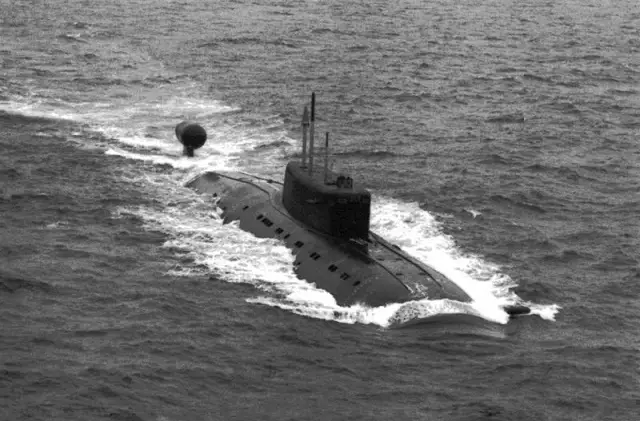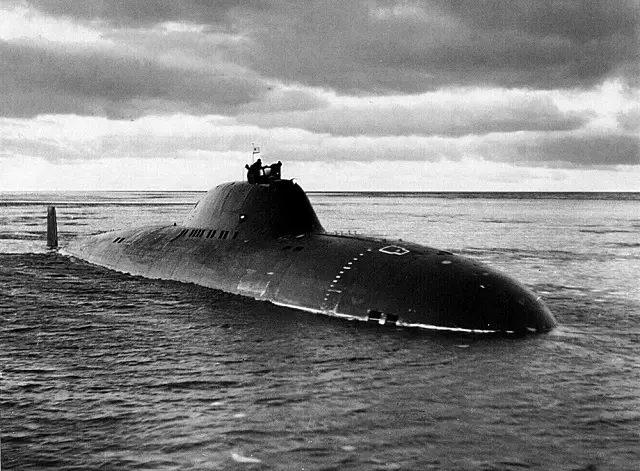Breaking news
Russian Navy Looking at Ways to Reduce the Crew Size of its Nuclear Submarines.
| 2016
 Project 945 Barracuda-class (Sierra I) titanium-hull submarine |
|||
The
Lira-class submarines featured extremely high acceleration and maneuverability
owing to their main propulsion plants. They were able to gain full speed
in 1 min., with their acceleration rate similar to that of a plane. Their
high speed enabled them quickly to get into a dead area of any surface
ship or submarine, even if the enemy sonar had detected them. The submarines
in the class could tail the potential enemy's boats for hours, preventing
them from either breaking contact or attacking. The high speed and maneuverability
of the Project 705 submarines allowed a full-speed 180-deg. turn in only
42 s. The Liras did not allow opposition to get into their rear dead areas
that were especially useful for stealthy stalking and attacking with a
torpedo. However, the submarines of the class had considerable drawbacks as well, the principal one being high noise. Their mechanisms would malfunction, and their repair was very difficult due to the shortage of spares and hampered access to units and instruments. The small crew - a strong point of the design - made it impossible for the submarines to be maintained at sea. The Project 705/705K ships' integrated automation made no provision for controlling the systems in an emergency, and, since the electronic componentry had grown obsolete, its reliability deteriorated. The reactor peculiarities resulted in the submarines of the class being able to be serviced at three Soviet naval bases only. The reliable maintaining of the liquid-metal coolant's temperature by means of on-shore equipment proved impossible, and the job was done by the heat radiated by the reactor itself. This led to its expedited service life expiry. The cramped compartments of the submarines offered poor habitability and accommodation for their complements who were dissatisfied with the low reliability of the ships as a whole. However, is it possible today to develop a submarine similar to the Lira and does the Russian Navy need it? According to military expert opinion, there is no technical problems preventing the development of small-screw submarines now. Automation systems have evolved much since then, and 21st-century action information systems have to meet utterly different requirements. For instance, Yasen-class (Severodvinsk-class) multirole submarines are highly automated ships. Their Okrug action information system exercises real-time monitoring of their combat systems and information both on the ship's status and fed by the observation and target designation equipment. However, the operation of sophisticated automated systems has certain standards for crewmen to meet. Ideally, the crews of such submarines could total 64 commissioned and warrant officers, but they actually account for 93. The more sophisticated the equipment, the higher skillful the use. Thus, fitting submarines with automated systems often increases their complements instead of reducing them. Automating naval hardware to slash crews is the long-time trend in the world's major navies. First, it is due to the crew consuming a sizeable part of the budget. On the other hand, a small crew hampers survivability: a large crew can contain underwater damage or put out a fire and control the ship at the same time, while a small one cannot. Finally, there are other issues with future robotized submarines. First, is Russia's defense industry capable of building a series of ships like that? Second, can the Defense Ministry afford such programs now that there is an economic recession? For instance, the Severodvinsk-based Zvyozdochka Shipyard had to suspend the upgrade of two Project 945 Barracuda-class (Sierra I) titanium-hull submarines - the B-239 Carp and B-276 Kostroma in the winter of 2014/2015. The cause was a cut in the military spending due to the financial crisis and, as the military believed, an excessive cost of the program. It became known late in 2016 that the Navy had decided to have two Project 677 Lada-class (Petersburg) submarines completed and terminate the series at that. The funds will be reallocated to the advanced Kalina program with the first submarine to be built only after 2020. Therefore, the resurrecting the Lira may encounter considerable problems - financial ones in the first place, military experts presume. © Copyright 2015 TASS. All rights reserved. This material may not be published, broadcast, rewritten or redistributed. |
|||



























